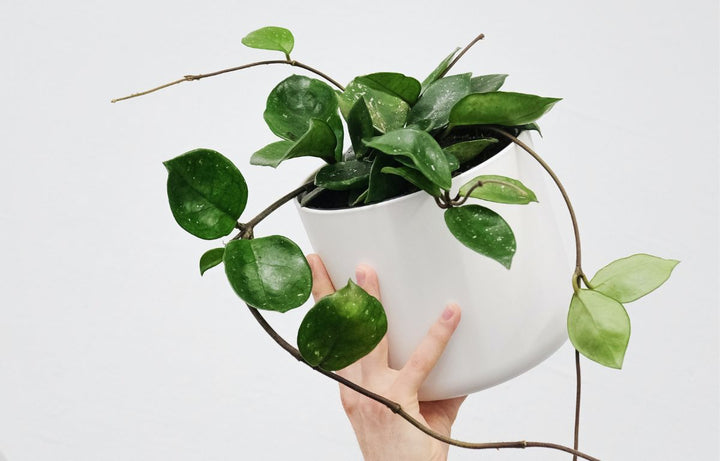
Plant Profile: Hoya Obovata
Plant Profile: Hoya Obovata
Among the vast array of houseplants, Hoya Obovata stands out as a true gem. Also known as the Wax Plant due to its natural shine, it is distinguishable due to its long string-like stems and dark green plump, white-flecked disk-shaped leaves. It is a highly fast-growing plant and easy to keep green and lush, perfect for beginner plant enthusiasts and expert gardeners alike.
Although the foliage is stunning on its own, Hoyas are also flowering plants. The Hoya Obovata produces stunning tiny clustering star-shaped white flowers with deep burgundy centres that give off a sweet chocolatey scent when in bloom.

Positioning:
Hoyas are native to the tropics of Indonesia and the north-easterly parts of Australia and are found in dense jungle regions that are naturally shaded and exposed to sunlight at different times of the day and year.
Regular bright indirect sunlight or constant interchanging of direct and indirect sunlight is a good alternative. Be sure not to overexpose your Hoya Obovata to direct hot sun as it can burn the leaves.
Soil:
Hoyas prefer well-draining soil that has an abundance of peat, perlite, and orchard bark which will allow as much aeration around the roots as possible. Succulent-specific soil is an easy alternative.
They are fast-growing plants and will thrive with regular fertilisation every 2-4 weeks during the warmer months. Fertilisation is not needed during the colder months as the plant will naturally slow growth to conserve energy.
Water:
Hoyas store water in their leaves so they prefer soil that is slightly damp to the touch. However, the subsoil should be completely dry before re-watering.
Always water less frequently during the colder seasons, but when you do water, the soil and roots should be fully soaked regardless of the seasons. Check to make sure the water is not pooling inside of the pot and is able to drain away.
Humidity:
Indonesia and the north-easterly regions of Australia have a humid and tropical atmosphere, so Hoyas generally prefer damp and warm environments of around 25C. However, they are tolerant plants and can withstand varying degrees of dryness and humidity when grown indoors.
Temperatures can range anywhere between 15-35C if altered incrementally. If the leaves appear to shrivel or wrinkle during dry periods, try misting them with a spray bottle to increase the water content in the air.
Avoid placing your Hoya near air conditioning and heating units and drafty doorways and windows, as sudden and extreme changes in temperature are harmful.

Problems and Solutions:
Hoyas are one of the few plants that like being slightly root-bound and are more likely to flower when it is. Having said that, if you find it difficult to poke your finger into the soil when checking the dampness or notice that your Hoya requires unusually frequent watering, it’s time to replant it into a slightly larger pot with new soil.
Hoyas only start producing flowers when they reach 2-3 years old, and they can be quite particular. If a few years have passed and your Hoya is still not flowering, try changing your plant’s habits by moving it into a sunnier or shadier location, increasing or decreasing watering and introducing fertiliser more frequently.
When the flowers have died back, do not remove the stalks as they will rebloom from them the next time.
Hoyas are susceptible to pests such as Aphids and mealybugs which suck the sap from the leaves of the plant. Because of this, Sooty Mould is a common disease that can grow on damaged, sap-covered leaves. The easiest way to remove pests and Sooty Mould is to gently wipe down the leaves and stems of the plant with a lukewarm damp cloth.
